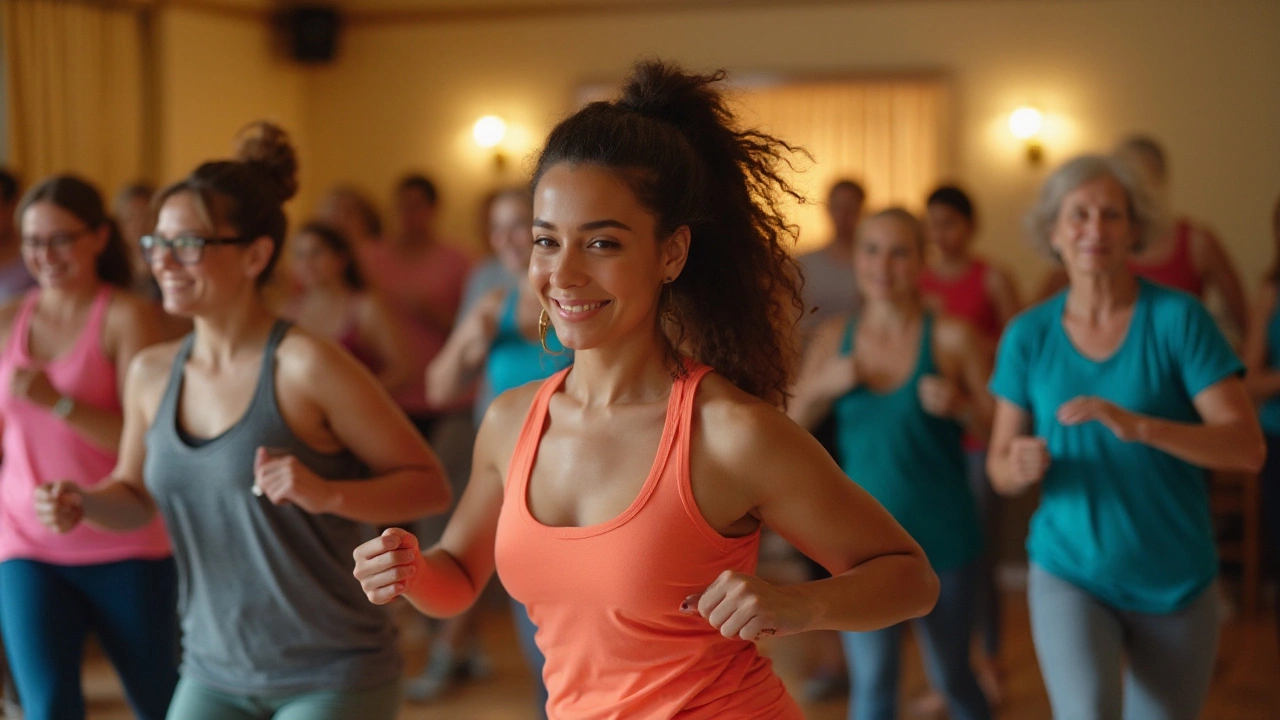
Diving into the world of fitness can be both thrilling and overwhelming, especially when the goal is to lose weight. The variety of classes available today means there's something for everyone, whether you prefer a heart-pounding session or something more zen.
It's important to pick a class that resonates with both your body and spirit. Some swear by high-octane HIIT, where short bursts of activity promise big results, while others find themselves grooving away calories in dance classes. Not to be overlooked are strength training programs that not only torch fat but also build muscle, which further amps up metabolism.
Even classes traditionally seen as more gentle, like yoga or pilates, bring a unique flair to weight loss, offering tone and flexibility along with a calmer mind. Each class offers serendipitous benefits, turning the journey of shedding pounds into one of discovery and enjoyment.
- Understanding Your Fitness Goals
- High-Intensity Interval Training (HIIT)
- Dance-Based Cardio Classes
- Strength and Conditioning Programs
- Mindful Movement Practices
Understanding Your Fitness Goals
When embarking on a journey to shed those pounds, it's crucial to first crystallize your fitness goals. Understanding what you want to achieve will not only steer you towards the right workout class but also keep you motivated along the way. Whether your aim is to lost weight or to improve endurance, acknowledging your current fitness level and health status is a great starting point. It’s about charting a course that is realistic and sustainable, considering personal limitations and strengths.
Setting specific, measurable, achievable, relevant, and time-bound (SMART) goals can be incredibly helpful. For instance, instead of vague aspirations like "get fit," aim for "lose ten pounds in three months by attending spin classes." This clarity transforms abstract desires into actionable plans, providing a tangible roadmap that guides every step towards success. According to a study by the American Council on Exercise, setting such precise objectives increases the likelihood of adopting continual, healthy practices by 25%.
Another important aspect is to choose a workout that enhances personal enjoyment. If simplicity and fun are key motivators, dance-based cardio might be the answer. For those who thrive on intensity, HIIT could be the thrilling challenge your routine needs. The idea is to pair your goals with activities you find intrinsically rewarding so that each session is something to look forward to and not just another box to tick.
"Fitness is not about being better than someone else. It’s about being better than you used to be," says motivational speaker Khloe Thompson.
Monitoring progress is equally vital in understanding fitness goals. Regular assessments can reveal how far you’ve come and what hurdles remain. Keep a journal or use apps designed to track workouts and results, thus continually aligning your efforts with your goals. Seeing steady improvements, whether in weight loss metrics or increased stamina, builds confidence and reinforces commitment to keep pushing forward.
| Type of Goal | Description |
|---|---|
| Weight Loss | Lose a specific number of pounds within a set timeframe. |
| Endurance | Increase the time or distance one can sustain aerobic exercise. |
| Strength | Improve muscle power and lift heavier weights. |
| Flexibility | Enhance range of motion or stretch further in specific poses. |
High-Intensity Interval Training (HIIT)
Among the most popular classes for those aiming to shed pounds quickly, High-Intensity Interval Training or HIIT has claimed the spotlight. The beauty of HIIT lies in its time efficiency and the intense burst of energy it demands, which can give your metabolism a significant boost. In essence, HIIT alternates short periods of intense anaerobic exercise with less intense recovery periods. This pattern is repeated until the individual becomes too exhausted to continue or completes a set number of cycles. The workout typically lasts anywhere from 20 to 30 minutes, making it exceptionally effective for those with a busy lifestyle.
One of the winning attributes of HIIT is the way it kickstarts the metabolism post-workout—a phenomenon known as excess post-exercise oxygen consumption, or EPOC. This means you continue to burn calories long after the session ends. Studies indicate that HIIT can increase the resting metabolic rate for up to 24 hours after exercise. According to the American College of Sports Medicine, HIIT workouts can dramatically improve aerobic and anaerobic fitness levels, alongside reducing fat and improving blood pressure.
The Mayo Clinic notes, "High-intensity interval training provides similar benefits as other forms of exercise in a shorter amount of time."
The versatility of HIIT is another reason for its mass appeal. You can incorporate bodyweight exercises, weights, or even cardio machines such as bikes and rowers. It’s simple to tailor the routine to match your current fitness level, scaling both the intensity and duration of time spent on each exercise and rest phase. The aim is to maximize the cardiovascular benefits while enhancing endurance. The fact that HIIT requires no specialized equipment means that it can be done virtually anywhere, from your living room to the local park. Research supports the use of HIIT for fat loss, showing a more pronounced reduction in abdominal fat compared to other forms of moderate-intensity training.
For beginners eager to dive into HIIT, it’s vital to start slow and gradually increase the intensity. A typical beginner’s routine may include exercises like jumping jacks, burpees, push-ups, and squats. Importantly, proper technique and form should never be compromised in pursuit of speed, as the risk of injury is higher when performing high-intensity moves. As you progress, incorporating more complex movements or adding resistance with weights can help maintain the challenging nature of the workout, ensuring continuous improvements and results. HIIT’s ability to offer a customizable and scalable structure makes it appealing for anyone looking to lose weight swiftly while strengthening their entire body.

Dance-Based Cardio Classes
When it comes to combining fun with fitness, dance-based cardio classes stand in a league of their own. These classes are not just about learning new dance moves; they are a celebration of movement, rhythm, and self-expression, all while burning serious calories. The magic lies in their ability to turn exercise into a joyful activity where participants might forget they're even working out. Popular classes like Zumba, Cardio Hip-Hop, and Jazzercise cater to different tastes but share the common goal of enhancing cardiovascular health and promoting weight loss. The best part? People of all ages and fitness levels can join, making them incredibly accessible.
Zumba, for example, has transformed fitness routines since it was first introduced. It employs easy-to-learn Latin dance steps to upbeat music, which makes it a global phenomenon. These sessions are a cardio workout planned to enhance endurance and muscle tone while keeping the energy levels high. According to studies, one hour of vibrant Zumba can torch around 500 to 1,000 calories, depending on the intensity and effort. That's quite an effective way to meet weight loss goals! Whether you're stepping to salsa beats or swinging to merengue, it’s an ideal way to burn off those calories without a treadmill in sight.
Cardio Hip-Hop offers a more street-style take on dance cardio, tapping into the energetic world of hip-hop music. These classes often replicate the excitement of a dance party with dynamic and powerful moves. With each session, participants build not only their aerobic capacity but also gain skills that can boost confidence on the dance floor. It's a workout meant for those who thrive on pushing boundaries and keeping things lively. As fitness expert Joe Smith notes,
"Dance cardio challenges coordination and balance while delivering a full-body workout, unlike any other."
Jazzercise, with its blend of jazz dance, resistance training, Pilates, yoga, and kickboxing, provides a comprehensive workout drawing from various disciplines. What makes it particularly effective is its structured format, combining the best aspects of different fitness systems into a single class. Such diversity ensures you top up your cardio while also engaging in resistance moves that tone and strengthen your muscles. Interestingly, participants can burn up to 800 calories per session, akin to a serious gym workout.
Most importantly, dance-based cardio classes offer a unique atmosphere that fosters social interaction and community. Unlike solitary gym workouts, these classes encourage you to engage with others, often leading to new friendships. This social aspect can be an excellent motivator, especially for those who find it challenging to maintain exercise routines. Remember, consistency is key to achieving any weight loss goal, and what better way to stick with it than by having fun?
In conclusion, dance-based cardio classes provide an encouraging, energizing path to losing weight effectively while enjoying every step of the journey. Whether it's the vibrant sway of salsa or the rhythmic stomp of hip hop, these classes promise a sweat-breaking workout that feels less like exercise and more like a celebration.
Strength and Conditioning Programs
Strength and conditioning programs are essential pillars in the quest for weight loss success. These classes go beyond just losing pounds; they build a robust foundation through muscle training which, ironically, helps incinerate calories more efficiently throughout the day. When you lift weights or participate in resistance-based exercises, you not only build muscle but also increase your resting metabolic rate. This means your body will burn more calories at rest, making it easier to maintain or reduce weight over time. It's quite fascinating how managing muscle mass translates seamlessly into weight management.
One of the greatest advantages of strength and conditioning workouts is their versatility. These sessions might involve free weights like dumbbells, kettlebells, and barbells, or use bodyweight movements such as planks, push-ups, and squats. The adaptable nature of these classes ensures that they cater to beginners and seasoned athletes alike. What makes these programs exceptionally effective is their focus on compound movements — exercises that target multiple muscle groups at once. For instance, a squat targets not only your leg muscles but also engages your core and even your back muscles.
"Strength training not only burns calories but also offers increasing strength, bone density, and metabolic health," explains strength coach John Rusin.Participants find that these workouts improve other areas of their lives, such as endurance, posture, and balance. Conditioning routines often include circuit training, where each 'station' in the class offers a different exercise targeting various body parts. This variety keeps workouts fresh while maximizing calorie burn. Clarity in movement forms is always emphasized, reducing injury risk and promoting longevity in one’s fitness journey.
The social aspect of these programs shouldn't be overlooked either. Many fitness classes foster a community environment where participants support each other's progress and celebrate milestones. This camaraderie not only makes the process of participating enjoyable but also encourages consistent attendance, which is crucial for achieving desired results. A wealth of studies underscores the impact of exercising in a group setting, showing significant improvements in both physical results and mental well-being when compared to working out solo.
Consider the principles of progressive overload at play during these sessions. Each week brings a new challenge: lifting heavier, adding extra reps, or even reducing rest times. This incremental increase triggers the body's adaptive responses, ensuring your stamina and muscle growth continue surging upwards. The concepts of periodization are often integrated into the curriculum, offering various phases throughout the year to focus on different aspects such as strength, hypertrophy, or endurance. Sticking to a well-structured plan leads to lifestyle changes that make it easier to keep off the lost weight.

Mindful Movement Practices
In the extensive realm of fitness, mindful movement practices such as yoga and pilates have carved a niche that transcends physical benefits. These practices, characterized by their focus on mental presence, offer a holistic approach to weight loss that's often overlooked in more traditional, high-intensity workouts. The essence of mindful movement lies in connecting the mind and body, enhancing awareness of physical cues, and cultivating a deeper appreciation for the body's abilities. As you engage in these practices, you become more in tune with how your body moves, strengthening your internal cues that dictate when to eat and when to rest, contributing significantly to a balanced approach to weight management.
Yoga, for instance, combines breath control, flexibility, and strength, creating a unique exercise environment that not only enhances your physical health but also nurtures your mental well-being. The various forms of yoga, from the intense flow of Vinyasa to the restorative nature of Yin, offer flexibility that caters to different levels of strength and mobility. The body burns calories as you transition through poses, engage muscles, and maintain holds, contributing to calorie deficit, which is essential for weight loss. Furthermore, yoga's emphasis on balance and being present aids in reducing stress levels, which can be a critical factor in weight gain. A study highlighted in the International Journal of Yoga pointed out that consistent yoga practice could improve metabolism and lower body mass index (BMI), making it a viable option for sustainable weight management.
Pilates, another excellent choice, focuses heavily on core strength while improving flexibility and body awareness. This practice promotes better posture and balance, which not only prevents injury but also enhances daily functional movements. As you engage your core during pilates sessions, you stimulate muscle groups that contribute to increased calorie burn, aiding in effective weight loss. A fascinating aspect of pilates is its adaptability; it welcomes people of all fitness levels with modifications for each exercise. Joseph Pilates, the founder of the practice, once said:
"Physical fitness is the first requisite of happiness."This sentiment underscores the importance of a healthy body for a fulfilling life, with Pilates offering a pathway to achieve that health and happiness balance. With its low-impact nature, pilates minimizes the risk of joint and muscle strain, making it accessible and effective for anyone aiming to shed weight without the extreme pressures of high-impact workouts.
Integrating mindful movement practices into your fitness regimen doesn't mean sacrificing intensity for tranquility; rather, it enhances your journey towards weight loss with added benefits of mental clarity and stress reduction. Combining yoga or pilates with a more vigorous workout routine might strike the ideal balance for those aiming to lose weight while maintaining a holistic approach to health. These practices encourage consistency, which is pivotal for any weight loss program's success. As you lose weight, the internal focus and calmness obtained through these sessions become indispensable tools, aiding not just in weight management but in enriching your quality of life, making exercise an enjoyable rather than obligatory task. For those who wish to document their progress, many find it helpful to keep a journal during these sessions, jotting down their experiences and reflections, further enhancing the mindfulness aspect of their journey.
